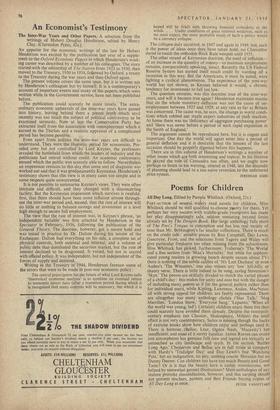An Economist's Testimony
The Inter-War Years and Other Papers. A selection from the writings of Hubert Douglas Henderson, edited by Henry Clay. (Clarendon Press, 42s.) AN appetite for the economic writings of the late Sir Hubert Henderson was excited by the publication last year of a supple- ment to the Oxford Economic Papers in which Henderson's work- ing career was described by a number of his colleagues. The story started with the editorship of The Nation from 1923 to 1930, then moved to the Treasury, 1930 to 1934, followed by Oxford, a return to the Treasury during the war years and then Oxford again.
The present volume covers the same span, but it is written not by Henderson's colleagues but by himself. It is a contemporary's account of important events and many of the papers, which were written while in the Government service, have not been published before.
The publication could scarcely be more timely. The extra- ordinary economic upheavals of the inter-war years have passed into history, leaving behind them a potent myth which urAil recently was too much the subject of political controversy to be examined seriously. Now at last the Conservative Party has extracted itself from the association with unemployment which it earned in the Thirties and a realistic appraisal of a complicated period has become possible. Even apart from 'politics the inter-war years are difficult to understand. They were the Homeric period for economists. Pre- sided over but not controlled by Lord Keynes, the professors invaded the battlefield from which the leaders of industry and the politicians had retired without credit. An academic controversy ensued which the public was scarcely able to follow. Nevertheless an impression remains to this day that some sort of diagnosis was worked out and that it was predominantly Keynesian. Henderson's testimony shows that this view is in many cases too simple and in some respects quite unwarranted.
It is not possible to summarise Keynes's views. They were often intricate and difficult, and they changed with a disconcerting facility. But the Keynesian impression which survives is twofold; first, that there should have been more inflation almost through- out the inter-war period and, second, that the rate of interest will do little or nothing to balance savings and, investment at a level high enough to secure full employment.
The view that the rate of interest was, in Keynes's phrase, 'an independent variable' was first attacked by Henderson in the Spectator in February, 1936, following the publication of the General Theory. The doctrine, however, got a secure hold and was tested in practice by Dr. Dalton during his tenure of the Exchequer. Dalton had everything on his side, a complete set of physical controls, both external and internal, and a volume of public debt that-dominated the securities market, but the rate of interest declined to be dragooned. It varied, but not in accord with official policy. It was independent, but not independent of the forces of supply and demand.
Writing in the Treasury in 1944, Henderson foresaw some of the errors that were to be made in post-war economic policy : The central prescription for the future of what Lord Keynes calls 'theoretical economic analysis' is to combine an eventual return to economic laisser faire (after a transition period during which it is recognised that many controls will be necessary, but which it is hoped will be brief) with throwing financial orthodoxy to the winds. . . . Under conditions of great external weakness, such as we. must expect, the more probable result of Such a policy would be a currency collapse.
The collapse duly occurred, in 1947 and again in 1949, but, such is the power of ideas once they have taken hold, no Chancellor dared to touch the orthodox Bank Rate weapon until 1951. The other strand of Keynesian doctrine, \he need of inflation— of an increase in the quantity of money—to maintain employment remains, comparatively speaking, intact. Recently the US Federal Reserve System has earned itself much credit by warding off a recession in this way. But, the Americans, it must be noted, were fighting a cyclical phenomenon. The experience of the post-war world has not shown, as Keynes believed it would, a chronic tendency for investment to fall too low.
The question remains, was this doctrine true of the inter-war years, and will it become true again? Henderson maintains stoutly that on the whole monetary deflation was not the cause of un- employment between 1923 and 1929, at any rate as far as Britain was concerned. The cause was, he says, the change in world condi- tions which robbed our staple export industries of thdr markets. At home there was no 'deficiency of aggregate purchasing power' and 'there was never before a period of such rapid expansion in the South of England.'
The argument cannot be reproduced here, but it is cogent and important. One day the world will again enter into a period of general deflation and it is desirable that the lessons of the last occasion should be properly digested before this happens.
There are in this volume of Henderson's writings a number of other issues which are both interesting and topical. In his lifetime he played the role of Cassandra too often, and we ought now perhaps to listen to his warning, uttered in 1948, lest the discredit of planning should lead to a too naive reversion to the unfettered


































 Previous page
Previous page